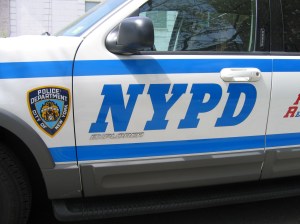3 Sources of Cluelessness Conspire to Blame Victims for “Distracted Walking”
Oy. Not great to hear @CommissBratton talking about distracted walking as reason for increase in nationwide increase in ped fatalities.
— Brooklyn Spoke (@BrooklynSpoke) March 10, 2016
For a policing icon who built his reputation on being data-driven, NYPD Commissioner William Bratton has a penchant for shooting from the hip on traffic safety.
At the Vision Zero conference yesterday, Bratton cited distracted walking as a reason pedestrian deaths in the U.S. are rising.
U.S. pedestrian deaths were indeed up last year, perhaps by as much as 10 percent. But how does Bratton know that an uptick in distracted walking — texting, earbudding and the like — played a part in the nationwide rise? How about in New York City? Has Bratton heeded the entreaties of street safety advocates and instructed the NYPD’s Collision Investigation Squad to data-mine its traffic death forensics to ferret out primary causes like drivers’ aggressive turning, speeding, texting, and curb-jumping, vis-à-vis screen-absorbed pedestrians walking into buses?
Unlikely. A better guess is that Bratton’s source was an AP story that ran earlier this week. Here’s the lede (emphasis added):
Pedestrian deaths surged by an estimated 10 percent last year as the economy improved, the price of gas plunged and motorists put more miles behind the wheel than ever before, according to an analysis of preliminary state traffic fatality data.
The growing use of cellphones distracting drivers and walkers may also be partially to blame, states a report released by the Governors Highway Safety Association, which represents governors’ highway safety offices.
Into the maze we go: The governors’ association report, Pedestrian Traffic Fatalities by State, compiled preliminary first-half 2015 traffic deaths from all 50 states. It found that data from the Federal Accident Reporting System indicate a 6 percent rise in U.S. pedestrian deaths in the first six months of 2015 compared to the same six months of 2014, and adjusted the increase to 10 percent, based on the previous pattern of undercounting in preliminary FARS data. That adjustment may well be reasonable. But the report doesn’t have a scintilla of evidence that any of the increase may have been due to pedestrians’ distracting themselves with devices — or to any other behavioral changes, for that matter.
Meanwhile, though the report doesn’t say so, all U.S. road deaths — which outnumber pedestrian fatalities roughly 7 to 1 — also increased in the first half of last year. Definitive figures aren’t available, but media accounts suggest the increase was at least as steep as the rise in pedestrian fatalities. For example, the veteran auto-industry reporter Doron Levin, now at Fortune magazine, wrote last year:
NHTSA [the National Highway Traffic Safety Administration] reports auto-related deaths increased 9.5% in the first three months of the year; NSC [the National Safety Council] says there has been a 14% jump in the first six months. (The groups use different statistical methodolgy.)
Here’s the rub, then: If the percentage increase in U.S. pedestrian deaths last year turns out to have been in line with the rise in all U.S. road traffic deaths, why would a possible increase in distracted walking mentioned by the governors’ association — or any change in pedestrian behavior, for that matter — have been a contributory factor? Wouldn’t the default presumption be that changes in behaviors by motorists — more driving, and, possibly, more dangerous driving — having caused a (presumed) 10 percent increase in all road deaths, would also have been largely responsible for the 10 percent increase in pedestrian deaths?
I’m seeing three distinct but mutually reinforcing sources of cluelessness here. There’s the governors’ association, which floats an insidious idea untethered to data. There’s the media (AP), which gives voice to it without checking it out. And there’s the NYPD, which as always stands ready to reproach vulnerable road users whom it can’t be bothered to protect.
I don’t know if distracted pedestrians are unwittingly killing themselves. Neither does the governors’ association or Bill Bratton. But police and state governments are sitting on a mountain of data. If they won’t take advantage of it, they should turn it over to public health advocates who will.
